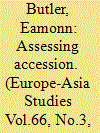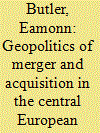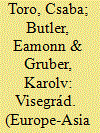|
|
|
Sort Order |
|
|
|
Items / Page
|
|
|
|
|
|
|
| Srl | Item |
| 1 |
ID:
128987


|
|
|
|
|
| Publication |
2014.
|
| Summary/Abstract |
On 1 May 2014, the European Union (EU) celebrated the tenth anniversary of the accession of ten member states-Cyprus, Czech Republic, Estonia, Hungary, Latvia, Lithuania, Malta, Poland, Slovakia and Slovenia. Of these ten new members, eight were Central and East European (CEE) countries that had, for most of the twentieth century, been governed by communist regimes either as republics of the Soviet Union (Latvia, Lithuania and Estonia), satellite states of the Soviet Union (Poland, Hungary, Czech Republic, Slovakia) or as a constituent republic of Yugoslavia (Slovenia). In the subsequent ten years three additional post-communist countries have acceded to the EU (Romania and Bulgaria in 2007 and Croatia in 2013). Commenting on the 2004 EU accession of the first eight former communist countries, the then Irish Prime Minister and President of the European Council, Bertie Ahern, wrote that there was
a particular historical resonance as eight of the former communist countries in the east have emerged from the shadows of the Iron Curtain to join us in working for common goals and for mutual benefit. The artificial divisions, which have blighted our continent's history for so long, are finally being laid to rest.1
|
|
|
|
|
|
|
|
|
|
|
|
|
|
|
|
| 2 |
ID:
106744


|
|
|
|
|
| Publication |
2011.
|
| Summary/Abstract |
In September 2007 the Austrian oil and gas company, OMV, issued a declaration of intent to merge with its Hungarian competitor, MOL. The merger was regarded by MOL as a hostile takeover bid and it initiated a series of measures designed to defend its independence and position within the Central European energy market. These measures, while intended to shore up MOL's defences in the face of an increased threat of merger and acquisition from larger companies aided by the demands of the EU to liberalise the energy market, reflect the rising instance of economic nationalism within the EU and have specific implications for the promotion of solidarity at an EU level. At the same time they also reflect the increased securitisation of energy. This is important when you consider that the actions of multiple players in the battle for MOL, including Russia through involvement of Surgutneftegaz following its purchase of a series of MOL shares in March 2009, has effectively created an energy security dilemma, whereby the actions of one actor to increase its own security leads to retaliatory actions by a second actor threatened by the actions of the first. Within the Central European energy market this is happening on multiple levels and impacts the relations between EU member states, the EU and Russia. The article uses the MOL case to highlight how the geopolitics of merger and acquisition in the Central European energy market means it effectively operates in a state of persistent insecurity.
|
|
|
|
|
|
|
|
|
|
|
|
|
|
|
|
| 3 |
ID:
128989


|
|
|
|
|
| Publication |
2014.
|
| Summary/Abstract |
Multilateral, subregional partnerships are one of the defining features of contemporary European politics. The 2004 enlargement of the European Union introduced a new partnership entity to the mix-the Visegrád Group of states, comprising the Czech Republic, Hungary, Poland and Slovakia-which offers its members a useful model to discuss and represent common interests in a collective manner within the regional and international political landscape. The article provides a reflection on the evolution of the Visegrád Group of states since 2004. It examines four key policy areas (institutional candidacy, energy policy, eastern neighbourhood and defence policy) where the group has either learned some difficult lessons or is seeking to apply those lessons. The article suggests that the Visegrád Group's greatest strength lies in its flexibility to become more responsive to the challenges it faces and it is likely therefore to remain appealing to its member states and to be a permanent feature within the wider cohort of European Union subregional partnerships.
|
|
|
|
|
|
|
|
|
|
|
|
|
|
|
|
|
|
|
|
|